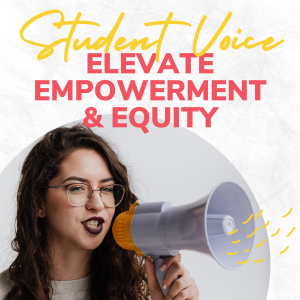[vc_row][vc_column][/vc_column][/vc_row][vc_row][vc_column][vc_column_text]
What Was the Need?
Like many large high schools, Westview High School struggled to serve all its students well and equitably, particularly students from historically underserved groups. For example, in 2005, only 2% of African American and Latino students at the school participated in advanced academic programs, while nearly 42% of students in these same groups were suspended at some point throughout the year (compared to 19% of all students). One of the key issues the Westview staff identified was that students in the large, comprehensive high school were not really known as individuals.[/vc_column_text][ultimate_spacer height=”5″][vc_column_text]Elementary school students generally spend the majority of their day, week, and school year with a single teacher who has direct responsibility for a small number of students. In contrast, middle and high school students generally spend a relatively small part of their day (45–60 minutes) with individual teachers, often changing teachers at the end of a quarter, semester, or trimester. The amount of time that an elementary student spends with their teacher in a week is equivalent to the amount of time a secondary student spends with each of their teachers in seven weeks. [/vc_column_text][ultimate_spacer height=”5″][vc_column_text] The leadership team realized that for their Multi-tiered System of Support (MTSS), it was critical that individual student’s unique strengths, interests, aspirations, needs, and family and community supports are recognized, so that effective decisions can be made to maximize students’ inclusion in the school. The team understood that they would need to think differently. They knew that most comprehensive secondary schools do not build structures or systems that allow students to be known in this way and thus decisions are often well-intentioned, yet ill-informed. Too often, decisions are made that push students further away from the inclusive learning environment desired by the caring adults making the decisions. They knew that it was critical for students to be known at the secondary level and they needed to employ structures, systems, and processes to ensure it. [/vc_column_text][ultimate_spacer height=”30″][/vc_column][/vc_row][vc_row][vc_column][vc_column_text]
The leadership team realized that for their Multi-tiered System of Support (MTSS), it was critical that individual student’s unique strengths, interests, aspirations, needs, and family and community supports are recognized, so that effective decisions can be made to maximize students’ inclusion in the school. The team understood that they would need to think differently. They knew that most comprehensive secondary schools do not build structures or systems that allow students to be known in this way and thus decisions are often well-intentioned, yet ill-informed. Too often, decisions are made that push students further away from the inclusive learning environment desired by the caring adults making the decisions. They knew that it was critical for students to be known at the secondary level and they needed to employ structures, systems, and processes to ensure it. [/vc_column_text][ultimate_spacer height=”30″][/vc_column][/vc_row][vc_row][vc_column][vc_column_text]
What Did They Do to Address the Need?
Westview decided to employ an instructional teaming model at the Grade 9–10 levels within a schoolwide house structure to ensure that a team of adults could know individual students and be capable of making quality decisions about the whole group (all students), small groups (some students), and individual students. As the school moved to implement an MTSS system, it split the school into three houses (Red, Silver, and Blue) serving approximately 900 students each. The houses each had several dozen teachers, an assigned assistant principal, two counselors, two special educators, and an ELL specialist.[/vc_column_text][ultimate_spacer height=”5″][vc_column_text]At the Grade 9–10 level within each house, an English language arts teacher and a social studies teacher shared 60 students across two class periods. Each pair shared two “pods” of 60 students (120 students total). Several of these pairs actually moved from 9th grade to the 10th grade with their pods of students. As part of the teaming infrastructure, embedded collaboration time was built into the master schedule (above and beyond individual plan periods), which allowed the two teachers to meet weekly with the assistant principal, counselors, special educators, and the ELL specialist within their house. This weekly team meeting constituted a type of MTSS team. Thus, Westview had approximately twelve “MTSS teams” built around 120 students that met weekly to engage in information gathering, decision making, and progress monitoring at the individual and group level. [/vc_column_text][ultimate_spacer height=”30″][vc_column_text]
How’s It Working?
This structure was put in place for a variety of reasons, but in large part the goal was to address the disproportionality Westview saw for African American and Latino students in terms of discipline (42% suspension rate compared to 19% for all students) and participation in advanced programs (2% participation compared to 38% for all students). While a range of other interventions were developed and implemented during this time, the teaming structure allowed quality decisions to be made at the individual level in terms of applying the appropriate interventions to each student, with an eye toward building on each individual’s strengths, interests, and aspirations. [/vc_column_text][ultimate_spacer height=”5″][/vc_column][/vc_row][vc_row][vc_column width=”1/4″][vc_single_image image=”42256″ alignment=”center”][/vc_column][vc_column width=”3/4″][ultimate_spacer height=”30″][vc_column_text]Within three years of implementing this structure, suspension rates dropped from 42% to 9% for African American and Latino students (6% for the school as a whole), and within six years participation rates of the same groups in advanced programs moved from 2% to 32% (40% for the school as a whole). [/vc_column_text][/vc_column][/vc_row][vc_row][vc_column][ultimate_spacer height=”30″][dt_fancy_separator separator_color=”accent”][ultimate_spacer height=”30″][/vc_column][/vc_row]




